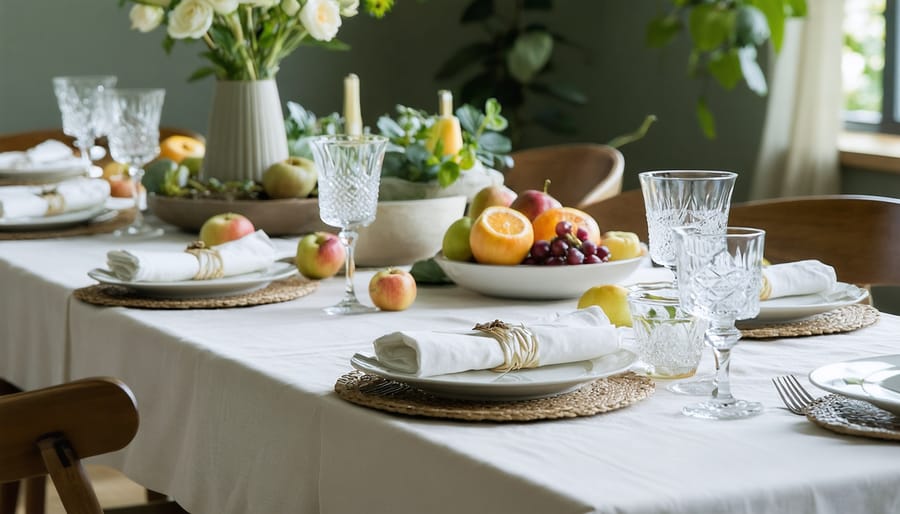
In a world where meals have become rushed pit stops between appointments, the mindful table offers a transformative return to presence and purpose. More than just a physical space, it’s an invitation to slow down, connect deeply, and savor not only our food but also the precious moments we share around it. When we create a mindful table, we’re crafting an experience that nourishes both body and soul, turning ordinary meals into meaningful rituals that ground us in the present moment.
Imagine your dining table as a sacred space where the chaos of daily life gently melts away. Here, the simple act of sharing a meal becomes a practice in mindfulness, gratitude, and connection. Whether dining solo or gathering with loved ones, the mindful table reminds us that eating isn’t just about sustenance – it’s about creating moments of joy, awareness, and intentional living in our increasingly fast-paced world.
The beauty of the mindful table lies in its accessibility; it requires no special equipment or expertise, just a willingness to be present and engage fully with our food and companions.
Setting the Stage for Mindful Dining
Creating Your Dining Sanctuary
Creating a mindful dining space doesn’t require a complete home renovation – it’s about thoughtful touches that engage your senses and promote presence. Start by decluttering your dining area, removing distractions like mail, phones, and other items that don’t serve the dining experience. Choose a comfortable seating arrangement that encourages good posture and allows everyone to see each other easily.
Lighting plays a crucial role in setting the mood – opt for warm, adjustable lighting that can be dimmed for intimate dinners or brightened for family breakfasts. I’ve found that adding a simple centerpiece, like a small potted herb or a bowl of seasonal fruits, brings nature to the table and creates a focal point for mindful appreciation. Consider incorporating elements from decorative ideas you might find inspiring, such as those in 10 Luxe DIY Home Decor Ideas to Elevate Your Space on a Budget.
Consider incorporating textile elements that please both eye and touch – a soft tablecloth or beautiful placemats can transform an ordinary table into an inviting space. Keep your dining chairs at a comfortable height and add cushions if needed. Remember, your dining sanctuary should reflect your personal style while maintaining a calm, welcoming atmosphere that encourages everyone to slow down and savor not just the food, but also the moment and company.
The Art of Table Setting
Setting a beautiful table doesn’t require expensive dinnerware or elaborate centerpieces. The key is to approach it with intention and creativity to create a special dining experience that elevates everyday meals. Start with a clean, uncluttered surface as your canvas. Even a simple cotton tablecloth or natural linen placemats can instantly transform the mood.
Layer your place settings thoughtfully – begin with a placemat or charger, add your dinner plate, and top with a salad plate if needed. Position utensils in order of use, working from the outside in. A well-folded napkin, whether placed under the forks or in a simple ring, adds an elegant touch.
For centerpieces, look to nature for inspiration. A small vase of fresh flowers, a bowl of seasonal fruit, or a few scattered autumn leaves can bring life to your table. Candlelight, even from simple tea lights, creates an intimate atmosphere that encourages slower, more mindful dining.
Remember, the goal isn’t perfection but creating a welcoming space that encourages connection and presence during meals.

Mindful Meal Preparation
The Meditation of Cooking
In our fast-paced world, cooking can become a precious moment of mindfulness – a chance to slow down and truly connect with the present moment. When we approach food preparation as a meditative practice, we transform a daily task into an opportunity to nourish mind and body in profound ways.
Begin by taking three deep breaths before you start cooking. Feel the weight of the knife in your hand as you chop vegetables, notice the vibrant colors of fresh produce, and inhale the aromatic herbs. There’s something magical about the rhythmic motion of stirring a pot of soup or the methodical process of kneading bread dough.
I’ve found that turning off notifications and playing soft background music helps create a peaceful cooking sanctuary. Take time to appreciate each ingredient’s texture and transformation. Whether you’re peeling an orange or measuring spices, let each action become intentional and purposeful.
Remember, cooking mindfully isn’t about perfection – it’s about being present in the process. When we cook with awareness, we infuse our food with positive energy and gratitude, making each meal we prepare more meaningful and enjoyable. This mindful approach naturally extends to how we experience the finished meal, creating a fuller, richer dining experience.

Choosing Ingredients with Intention
The art of mindful dining begins long before we sit down at the table – it starts with how we select our ingredients. I’ve found that taking a moment to pause in the produce aisle can transform a routine grocery run into an opportunity for connection and intention.
Consider the journey each ingredient takes to reach your kitchen. When choosing produce, let your senses guide you – feel the gentle give of a ripe peach, inhale the fresh aroma of herbs, notice the vibrant colors of seasonal vegetables. This sensory engagement helps us appreciate the natural abundance available to us.
Quality ingredients don’t always mean the most expensive options. Instead, focus on freshness, seasonality, and sourcing from places that align with your values. Local farmers’ markets offer wonderful opportunities to meet the people who grow your food and learn about their farming practices.
Remember that mindful ingredient selection extends beyond produce. Whether you’re choosing grains, proteins, or pantry staples, take time to read labels and understand their origins. This thoughtful approach not only leads to more satisfying meals but also helps us develop a deeper appreciation for the food that nourishes us.
By choosing ingredients with intention, we create a foundation for meaningful dining experiences that nurture both body and soul.
The Practice of Mindful Eating

The Five Senses Approach
Have you ever noticed how a simple meal can become an extraordinary experience when you truly engage all your senses? The Five Senses Approach is a cornerstone of any successful mindful eating practice, transforming routine meals into moments of pure joy and connection.
Start with sight: take a moment to appreciate the colors on your plate. Notice how the vibrant greens of fresh herbs contrast with the golden-brown crust of your bread, or how steam rises gracefully from your soup. Next, inhale deeply and let the aromas tell their story – perhaps it’s the earthy scent of mushrooms or the bright notes of fresh citrus.
Before taking your first bite, listen to the sounds around you. The gentle clink of cutlery, the crunch of fresh vegetables, or the subtle sizzle of a hot dish can all enhance your dining experience. When you finally taste your food, let it linger on your tongue. Notice the different flavor notes – sweet, salty, bitter, umami – and how they dance together.
Finally, pay attention to texture. Feel the smoothness of pureed soup, the tender resistance of perfectly cooked pasta, or the crisp snap of fresh vegetables. By engaging all five senses, you’re not just eating – you’re creating a fuller, richer relationship with your food and the present moment.
Remember, this isn’t about perfect execution; it’s about bringing awareness to each sensory experience, one meal at a time.
Gratitude and Connection
In our fast-paced world, mealtime offers a precious opportunity to pause and connect – both with our food and with those around us. Taking a moment before eating to express gratitude, whether silently or shared aloud, can transform an ordinary meal into a meaningful experience. This simple practice helps ground us in the present moment and acknowledges everyone involved in bringing food to our table, from farmers to food preparers.
Create a ritual of sharing gratitude by asking each person at the table to mention one thing they’re thankful for. This not only cultivates appreciation but also opens the door for deeper conversations and stronger bonds. For solo diners, keeping a gratitude journal near your dining space can help maintain this mindful practice.
Remember that connection isn’t limited to words – sharing food family-style, passing dishes, and making eye contact are powerful ways to strengthen relationships during meals. Even if you’re dining alone, you can feel connected to the broader world by reflecting on the journey your food took to reach your plate.
Consider starting a tradition of weekly gatherings where phones are put away, and the focus is purely on food and fellowship. These moments of genuine connection over shared meals often become our most cherished memories and help establish a positive relationship with both food and community.
Digital Detox at the Table
I’ll never forget the evening I realized my family’s dinner conversation had been replaced by the soft glow of our smartphones. That was our wake-up call to establish a “devices-free dining” policy, and the transformation was remarkable.
Creating a digital boundary around mealtimes isn’t just about eliminating distractions – it’s about reclaiming one of life’s most precious opportunities for connection. When we set aside our devices during meals, we open the door to meaningful conversations, deeper appreciation of our food, and genuine presence with our loved ones.
Consider starting with a simple device basket near your dining area, where everyone (yes, including you!) deposits their phones before sitting down to eat. You might be surprised by the initial resistance, but stick with it. The rewards – animated discussions, shared laughter, and the simple joy of tasting your food without the constant ping of notifications – are worth any temporary discomfort.
If you live alone, this practice is equally valuable. Instead of scrolling through social media while eating, try focusing on the flavors, textures, and aromas of your meal. Notice how different the experience feels when you’re fully present with your food rather than split between screens and sustenance.
Remember, this isn’t about strict rules or perfection. It’s about creating a space where genuine connection can flourish, one meal at a time.
Creating a mindful table is more than just a mealtime ritual – it’s a journey toward a more conscious and satisfying relationship with food. By incorporating these practices into your daily routine, you’re not just nourishing your body; you’re cultivating moments of presence and gratitude that can transform your entire dining experience. Start small by choosing one or two techniques that resonate with you, whether it’s setting a beautiful table, practicing mindful breathing before meals, or simply eating without distractions. Remember, there’s no “perfect” way to practice mindful eating – it’s about finding what works best for you and your lifestyle. As you continue on this path, you’ll likely discover that the mindful table becomes a cherished part of your day, offering a peaceful retreat from life’s constant demands. Why not begin your journey today with your very next meal?



